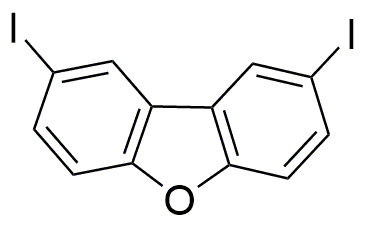2,8-Diiododibenzofuran is widely utilized in research focused on:
- Organic Electronics: This compound is used in the development of organic light-emitting diodes (OLEDs), enhancing the efficiency and color range of displays in consumer electronics.
- Pharmaceuticals: Its unique structure allows for the synthesis of potential drug candidates, particularly in targeting specific biological pathways, making it valuable in medicinal chemistry.
- Photovoltaics: The compound plays a role in creating organic solar cells, contributing to renewable energy solutions by improving light absorption and conversion efficiency.
- Material Science: It is utilized in the production of advanced materials with specific optical properties, beneficial for applications in sensors and imaging technologies.
- Research in Halogenated Compounds: The compound serves as a model for studying the effects of halogenation on chemical reactivity and stability, providing insights for chemists in various fields.
Informations générales
Propriétés
Sécurité et réglementation
Applications
2,8-Diiododibenzofuran is widely utilized in research focused on:
- Organic Electronics: This compound is used in the development of organic light-emitting diodes (OLEDs), enhancing the efficiency and color range of displays in consumer electronics.
- Pharmaceuticals: Its unique structure allows for the synthesis of potential drug candidates, particularly in targeting specific biological pathways, making it valuable in medicinal chemistry.
- Photovoltaics: The compound plays a role in creating organic solar cells, contributing to renewable energy solutions by improving light absorption and conversion efficiency.
- Material Science: It is utilized in the production of advanced materials with specific optical properties, beneficial for applications in sensors and imaging technologies.
- Research in Halogenated Compounds: The compound serves as a model for studying the effects of halogenation on chemical reactivity and stability, providing insights for chemists in various fields.
Documents
Fiches de données de sécurité (FDS)
La FDS fournit des informations de sécurité complètes sur la manipulation, le stockage et l’élimination du produit.
Spécifications du produit (PS)
Le PS fournit une description complète des propriétés du produit, notamment sa composition chimique, son état physique, sa pureté et les exigences de stockage. Il détaille également les plages de qualité acceptables et les applications prévues du produit.
Certificats d'analyse (COA)
Recherchez des certificats d'analyse (COA) en saisissant le numéro de lot du produit. Les numéros de lot et de lot se trouvent sur l'étiquette d'un produit, après les mots « Lot » ou « Lot de fabrication ».
Numéro de catalogue
Numéro de lot/série
Certificats d'origine (COO)
Ce certificat d'exploitation confirme le pays dans lequel le produit a été fabriqué, et détaille également les matériaux et composants utilisés et s'il est issu de sources naturelles, synthétiques ou autres sources spécifiques. Ce certificat peut être requis pour les douanes, le commerce et la conformité réglementaire.
Numéro de catalogue
Numéro de lot/série
Fiches de données de sécurité (FDS)
La FDS fournit des informations de sécurité complètes sur la manipulation, le stockage et l’élimination du produit.
DownloadSpécifications du produit (PS)
Le PS fournit une description complète des propriétés du produit, notamment sa composition chimique, son état physique, sa pureté et les exigences de stockage. Il détaille également les plages de qualité acceptables et les applications prévues du produit.
DownloadCertificats d'analyse (COA)
Recherchez des certificats d'analyse (COA) en saisissant le numéro de lot du produit. Les numéros de lot et de lot se trouvent sur l'étiquette d'un produit, après les mots « Lot » ou « Lot de fabrication ».
Numéro de catalogue
Numéro de lot/série
Certificats d'origine (COO)
Ce certificat d'exploitation confirme le pays dans lequel le produit a été fabriqué, et détaille également les matériaux et composants utilisés et s'il est issu de sources naturelles, synthétiques ou autres sources spécifiques. Ce certificat peut être requis pour les douanes, le commerce et la conformité réglementaire.


